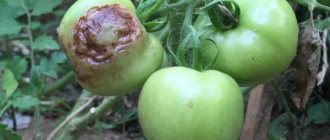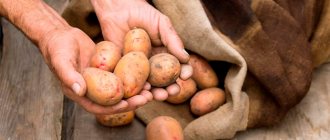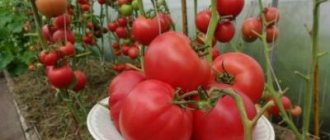» Vegetable growing » Tomatoes » Tomatoes are imposed, but refuse to turn red
0
14257
Article rating
The year turned out to be like this - the tomatoes don’t turn red and don’t ripen. And a lot has been imposed, which makes me happy, but they don’t want to ripen. Why is this, and is there any explanation?
Almost all gardeners face the problem of long ripening of tomatoes. They either begin to gain color when they are small, or they hang on the bushes, filled only with milkiness. Otherwise, the bottom of the fruit turns red, but the top remains green. There are many questions about this, but few answers.
When should tomatoes start turning red?
Before you start looking for the reasons that slow down the ripening of tomatoes on the bushes, you need to understand for yourself whether the tomato fruits actually take too long to ripen or whether everything is happening as usual, and you are just rushing things.
To clarify this, we need to delve into the physiology of tomato fruit development. It is known that, after the formation of the ovary, it takes approximately 1 month for the fruits to increase in volume to their usual size, becoming dense and green.
At the second stage of development, which lasts on average 15-20 days, the fruit ripens. At the same time, it first becomes light, then acquires brown colors and, finally, reaches biological ripeness, acquiring the fruit color characteristic of each specific variety: red, crimson, pink, yellow or another.
Normally, tomatoes ripen 40..55 days after the start of flowering, depending on the variety.
If tomatoes in your garden or greenhouse ripen as described above, then everything is fine with them and there is no need to worry in vain. However, if the tomatoes started normally and after 50 days they are still in no hurry to ripen, this is already an anomaly and it is necessary to search for the reasons that caused this phenomenon. Only by eliminating these reasons can you wait until the tomatoes ripen.
Secrets of ripening tomatoes at home
When growing tomatoes outside, harvesting is carried out when most of the tomatoes are still fairly unripe. This is explained by a lack of heat and sun: in most regions of Russia, summer passes quickly, and frosts begin in early autumn. Ripening must be done according to certain rules, otherwise the taste of the fruit will be spoiled.
Why do they carry out
When ripening (ripening), the tomato reaches its maturity. Its taste properties change in a positive direction, the color of the skin becomes red, and the flesh becomes juicy and sweet. Ripening is a necessary stage in growing tomatoes, since unripe fruits cannot be eaten. They are tasteless and, moreover, will cause poisoning of the body.
The process is most often carried out at home. Optimal conditions for tomatoes are created under which they begin to change. Ripe tomatoes are no different in taste and color from their predecessors, which were ripened on bushes in a greenhouse. They are used for any purpose: canned, cut into salads, salted, pickled, prepared tomato juices and paste.
When and how to collect
Green tomatoes are found not only in open ground, but also in greenhouses. Harvesting depends on the ripening period of the variety.
If a tomato variety is characterized by a late harvest of fruits, then they should be collected no earlier than August. The main point is that unripe tomatoes must be collected before frost begins.
At low night temperatures (below zero), the taste begins to deteriorate, and the fruit itself begins to rot.
When harvested, tomatoes should reach their size, which is characteristic of the variety; a slight blush may appear on the skin.
The fruits are torn off with the stalk and placed in rows in a basket or wooden box. Since the flesh of green tomatoes is quite hard, you don’t have to worry about damaging the skin. Important!
Fruit collection is carried out in dry cloudy weather in the evening or in the morning.
If a tomato bush is infected with late blight, rot or other fungal diseases or viruses, then it is not advisable to collect the tomatoes growing on it. There is a high probability that a diseased tomato will infect a healthy one, and as a result, the entire crop will be ruined.
However, if there is a small affected area on the fruit, then before storage it must be scalded with boiling water or placed in hot water at 60-70 degrees. Infections die at high temperatures, and the tomato will be safe and can be eaten.
How to speed up ripening and its methods
The collected green vegetables are brought into the house or a warm room and left to ripen. In this case, you need to pay attention to several points:
- Dryness of fruits. After harvesting, all tomatoes must be wiped dry; moisture should not get on the skin, as the fruits quickly deteriorate.
- Ambient temperature. The temperature should be in the range from 15 to 25 degrees. The warmer the house is, the faster the ripening proceeds.
- To speed up the process, add a red tomato to the ripening tomatoes. It causes redness in neighboring fruits due to the ethylene released.
Normal way
Tomatoes are poured into a cardboard box and placed in a dark but dry place at a temperature of 22-25 degrees Celsius. The top of the box is covered with a dark cloth. After 3-4 days, the tomatoes are turned over to the opposite side so that the color acquires a beautiful color. After 2 weeks, even completely green fruits will ripen and are ready to eat.
In the sun
To quickly get red and sweet tomatoes, place them in rows on a sunny windowsill. Ripening occurs very quickly, so vegetables are constantly monitored so that they do not overripe. If you continue to keep ripe vegetables in the sun, they become ugly, wrinkled, and some of the taste is lost. Usually a week is enough for all the tomatoes to reach the desired condition.
In the package
Green tomatoes are placed in a plastic bag, but the top of the bag is not closed so that there is constant air access. The package is hung from the top of a curtain, a horizontal bar, or to any support. The tomatoes are left hanging for several days, every week the harvest is checked and the already ripe fruits are removed.
Further storage
Ripe vegetables are stored in a cool place. This could be a refrigerator or a basement. During storage, tomatoes should be without visible damage. Place the harvest in a bag without tying it and put it in the refrigerator. The shelf life of ripe tomatoes is no more than 2 weeks. It is not advisable to store vegetables at room temperature; they spoil in 2-3 days.
How to stop ripening
Some gardeners, on the contrary, want to extend the ripening period of tomatoes until autumn. This will allow you to enjoy ripe fruits even at the beginning of winter. To stop ripening, vegetables are stored in a cool place with a temperature of no more than 15 degrees Celsius.
The ideal storage space is a cellar, basement, attic. The tomatoes are placed in boxes or crates, covered loosely with lids and several ventilation holes are made in it. The boxes or boxes are put into the basement, where the vegetables will be stored for several weeks.
Attention!
It is necessary to monitor the humidity in the room so that it is not high and the fruits remain dry.
Instead of boxes, you can put the tomatoes in plastic bags and hang them from the ceiling of the cellar. A low temperature will stop ripening, however, it does not contribute to its complete cessation; it proceeds with low intensity.
Sometimes tomato bushes are dug out of a greenhouse or open ground directly with the rhizome and suspended by the root from the ceiling, without separating the tomatoes from the branches. The tomatoes will sing right on the bush, because the stem continues to supply the fruit with the necessary nutrients for some time.
If the technology for collecting and storing fruits is violated, the harvest can be completely ruined. Ripening is considered a natural procedure and does not harm the quality of tomatoes, but only improves the taste characteristics.
Subscribe to our channel in Yandex.Zen! Click “Subscribe to channel” to read Otomatah.ru in the Yandex feed
Source: https://otomatah.ru/dozarivanie.html
Reasons why tomatoes may not turn red for a long time in a greenhouse, open ground and on the balcony
Many years of theoretical and practical research have made it possible to identify and highlight 4 main reasons why tomatoes ripen slowly in open ground, a greenhouse or on a windowsill. Below we will consider them in detail.
Uncomfortable growing temperature
This reason is perhaps the main and most common one. At temperatures below 15 degrees, and also when the thermometer exceeds plus 35, the production of the natural pigment lycopene in tomatoes stops, thanks to which the fruits acquire a red color.
If there is a deficiency of this element, the fruits may turn slightly brown and then do not turn red for a long time.
Bad light
This reason is also quite widespread. With a lack of light, which can be caused by excessive thickening of tomato bushes, the fruits ripen slowly and unevenly.
Usually, where there is an increased planting density of tomato bushes, small-sized fruits ripen on the upper clusters, where the lighting is normal, and large lower fruits, which do not receive sunlight, can remain brown for a long time.
Violation of the tomato diet
Often the cause of delayed ripening of tomatoes is improper fertilizing. For example, tomato bushes “get fat” from excess nitrogen fertilizers.
At the same time, they grow powerful stems and leaves, and insufficient nutrition is used to form fruits. As a result, small or ugly fruits are formed that cannot ripen for a long time.
Overloading bushes with fruits
This reason is most often found among inexperienced vegetable growers. They incorrectly perform the formation of bushes, leaving extra shoots and brushes on the plants.
As a result, tomato bushes produce more fruit clusters and cannot provide them with the necessary nutrition. Without receiving enough nutrients, tomato fruits ripen longer than usual.
How to speed up the ripening of tomatoes
There are several ways to help tomatoes ripen. First of all, you need to be careful about the choice of variety and its purpose. Thus, varieties intended for cultivation in a greenhouse do not need to be placed in open ground; they will not have time to ripen. There is no need to plant late-ripening varieties in the northern regions; they also will not have time to repay the harvest.
Open ground tomatoes such as Otradnye and Betta are perfect for growing in the northern regions.
Large varieties of tomatoes, such as Ox's Heart, Titan and others, take quite a long time to ripen.
If the varieties are selected correctly, but the fruits stubbornly do not want to turn red, use methods such as:
- In cool weather, do not open the doors in greenhouses, this will help raise the temperature and the tomatoes will begin to turn red;
- After the fruit has set on the lowest cluster, all the leaves that reach it from below are cut off. In this case, a pruning shear is used, it is disinfected in a solution of potassium permanganate after pruning each plant;
- When planting in dense areas, leaves are removed from the plants as much as possible to ensure access to the sun to the fruits;
- If the weather is hot, a mesh or thin non-woven fabric is stretched along the southern wall of the greenhouse so that the fruits do not bake in the sun;
- Fertilizing is carried out to provide the tomatoes with additional nutrition, a spoonful of kemira and a handful of ash are dissolved in a bucket of water and the bed is watered;
- Foliar feeding will also help speed up the ripening of tomatoes. Dissolve 35 drops of iodine in a bucket of water and spray the plants on the leaves. The fruits will begin to ripen soon;
- Preventive spraying against diseases is also carried out;
- When preparing the soil, its composition is important; if you overdo it with the application of nitrogen, you may not get fruit.
Phosphorus and potassium elements should predominate in the soil for tomatoes. I add ash, two tablespoons of superphosphate, the same amount of kemira and only a bucket of compost to the garden bed. Applying manure to a tomato bed is prohibited; it promotes elongation of the stems and vigorous growth of shoots to the detriment of the fruits.
What to pour on tomatoes to make them turn red faster and sweeter
Often, the reason for poor ripening of tomatoes is violations of the rules for using fertilizers. Lack and excess of fertilizers in the soil of vital macro- or micronutrients has a detrimental effect on the development of the plant as a whole, including the delayed ripening of fruits.
If the tomato bushes have acquired a dark green color, their stems have become thick and numerous shoots are growing from everywhere, this means that a lot of nitrogen fertilizers have been applied. Tomatoes need nitrogen at the start of the growing season for rapid growth of shoots and leaves.
Important! During setting, filling and ripening of fruits, phosphorus-potassium fertilizing and spraying of bushes with iodine-based preparations should prevail in the nutritional structure.
To even out the imbalance in nutrition, you need to urgently stop applying fertilizers containing nitrogen and feed the plantings with an infusion of ash and superphosphate extract. If there is too much nitrogen in the substrate, it may be necessary to pre-wash it with a large amount of irrigation water, and only then proceed to adding potassium, phosphorus and iodine.
Iodine-ash fertilizing of tomatoes for rapid fruit ripening shows good effectiveness. The recipe for its preparation is as follows:
- pour two liters of wood ash into a bucket;
- pour the powder into 5 liters of boiling water;
- wait for the solution to cool and add another 5 liters of water to it;
- cover the bucket with a lid and place it in the shade;
- after a week, drain the ash infusion into another bucket, adding 20 ml of a 5% iodine solution and 10 g of boric acid.
Before use, dilute 1 liter of the resulting concentrate with 9 liters of clean water. You can pour 1 liter of nutrient solution under each bush.
Superphosphate extract can stimulate the ripening of tomatoes. It is prepared according to the following algorithm:
- place 100 g of superphosphate in an enamel pan;
- fill it with 0.5 liters of boiling water;
- mix the contents well and place the pan indoors for 22 hours;
- during this time, thoroughly mix the suspension 6 times to better dissolve the granules;
- the next morning, drain the liquid extract from the sediment;
- dilute 20 tbsp. l. hoods 3 liters of water;
- Dilute 150 g of product in 10 liters of water.
Water the tomatoes with this working solution, pouring 1 liter of liquid under each root.
Interesting videos with tips from gardeners
How to protect tomatoes from diseases
It is important to take measures in time to protect tomatoes from various diseases, including late blight, for this I act as follows:
- Before planting, I water the finished bed with Gamair and Alirin-B, this eliminates late blight spores that overwinter and remain in the soil;
- Starting from the end of June, I spray with sour milk, dissolve a packet of milk or kefir in a bucket of water and apply it to the plants with a broom. If there are no signs of disease, then I repeat spraying once a week; if signs of disease appear, spraying is needed once every three days;
- Of the ready-made preparations, the preparations Khom and Oxychome help well.
I also use preventive measures such as timely removal of the lower leaves, and then all foliage in mid-August.
Causes of problems with tomatoes and how to solve them
In order for tomatoes to ripen smoothly and in a timely manner, you need to know about the reasons that inhibit the ripening of fruits and promptly eliminate them.
Why does a tomato turn red with green spots near the stalk?
For the normal development of tomatoes, including the timely ripening of fruits, temperature conditions are important. If, for a number of reasons, the temperature in the greenhouse drops below 15 degrees or exceeds 35 degrees, the tomatoes slow down their development and the fruits do not turn red. In addition, under such conditions, an uneven yellow-green edging appears around the stalk.
The same deviations in the color of tomato fruits occur when there is a large difference in day and night temperatures. This is explained by the fact that at high and low temperatures, the synthesis of the coloring pigment lycopene in fruits decreases, due to which tomatoes turn red.
To solve the problem in hot weather, you need to ventilate the greenhouse or install shading structures. On cool nights, you should turn on the heating in the greenhouse.
Young tomato fruits are deformed and quickly turn red
Often in tomato plantings in hot and sunny summers you can observe the following picture: the fruits become deformed and begin to quickly turn red. This usually occurs from exposure to direct sunlight.
Under the influence of ultraviolet rays, the fruits do not have time to ripen, becoming baked in the sun.
Why tomatoes don’t pour, but turn small red
This picture can be observed on tomato bushes overfed with nitrogen, especially with a deficiency of phosphorus-potassium fertilizers. The introduced nitrogen stimulates the growth of new shoots and very little nutrition goes to the fruits. In connection with this, after 50 days allotted by nature for the formation of fruits and their ripening, they do not have time to gain weight.
Tomatoes that have formed on the upper clusters and are in direct sunlight may turn small red.
The lack of phosphorus and potassium in plant nutrition also does not allow plants to form full-sized fruits. Such fruits eventually ripen small.
To eliminate the problem, you need to properly fertilize tomatoes during the growing season, regularly perform pinching, remove all leaves to the fruiting clusters and not exceed the planting density.
Why tomatoes don't turn red, but turn yellow
If in the greenhouse it is not possible to maintain a temperature comfortable for the growth of tomatoes at 22-28 degrees, then the processes associated with the synthesis of lycopene in the fruits are disrupted. As a result, tomatoes may turn yellow-orange in color, which then does not turn red.
One more point must be kept in mind here. There are varieties of tomatoes whose fruits always turn yellow when ripe. This is a varietal trait and does not change when growing conditions change.
Why tomatoes don't turn red, but turn black
Top rot
The main reason that tomatoes do not turn red, but turn black, are various fungal diseases. In conditions of sufficient temperature and high humidity, fungi develop rapidly, affecting the entire above-ground part of plants.
More information on why the fruits, stems and leaves of tomatoes turn black and what to do about it.
Diseases that cause tomato fruits to turn black are listed below:
- Late blight. This disease is very insidious and can significantly reduce the yield of tomatoes. Affects fruits, leaves, flowers and stems.
- Apex rot. It is characterized by the formation of black dry spots in the upper part of green fruits and young ovaries.
- Olive spot. This fungus mainly affects tomato leaves, causing brown spots to appear on them.
- Gray rot. With this disease, at the end of the fruiting period, which coincides with the onset of cold weather, the leaves, fruits and stems of tomatoes are affected.
- Fomoz. This fungus only affects fruits, at the base of which, near the stalk, a small black spot appears.
- Macrosporiasis. As a result of this disease, the fruits become covered with brown spots, and with high air humidity, a black coating appears on top.
To avoid significant crop losses from fungal diseases, you must adhere to tomato cultivation technology and regularly carry out preventive treatments of plantings with fungicides.
Why don't tomatoes turn red when picked from the bush?
Tomatoes picked from the bush may not turn red for a long time for a number of reasons. For example, if they were picked from the bush very early, before the first phase of ripening occurs, the fruit becomes clear. Another reason may be the very low temperature of the room where the fruits are ripened. Lack of lighting also slows down the ripening of tomatoes.
To speed up the ripening of green fruits, it is recommended to place mature specimens next to them. It has been established that ripe tomatoes release a little ethanol, which serves as an accelerator for the ripening of tomatoes.
Growing stepsons as a cause of thickening
Another condition for the speedy ripening of the crop is the normalization of fruit formation, i.e. the question “why don’t tomatoes turn red” will become natural if the new flower stalks growing in the axils of the leaves are not picked off in time. After all, tomatoes are very strong plants, rushing to reproduce as many fruits as possible, and their ripening can last indefinitely, since the culture devotes all its energy to the formation of new shoots. Therefore, the gardener is forced to direct the plant’s energy in the right direction, that is, to fill and ripen the set fruits. Stepchildren, which are rapidly turning into flower stalks, should be plucked 2-3 times a week.
In early August, pinch off the tops of all tall varieties, remove peduncles and branches with unset inflorescences, and remove all flower brushes from medium and low-growing tomatoes. Thus, the plant’s forces will be concentrated on filling the already formed fruits. True, even after this procedure, stepchildren appear with enviable regularity, so periodic pinching is carried out by gardeners constantly.
Recommendations from gardeners
Experienced gardeners advise not to remain indifferent when tomatoes do not turn red for a long time. They suggest using one of the simple and accessible methods of influence. Below are the most popular ways to speed up the ripening of tomatoes:
- Changing the orientation of the bushes in relation to the sun. To improve illumination, you need to remove excess leaves and turn the branches towards the sun. It is easier to perform this procedure in a greenhouse, where tomatoes grow on trellises using garter material.
- Iodine supplement. The redness of tomatoes can last for a long time due to iodine deficiency in the soil or artificial substrate. To correct the current situation, it is enough to carry out 2-3 foliar feedings with iodine solution. Why dilute 35 drops of the drug in 10 liters of water.
- Removing stepsons and leaves. To speed up the ripening of tomatoes, experienced gardeners remove the emerging shoots and lower leaves to the fruiting cluster, on which the fruits are already ripening.
- Decreased nutrition level. Vegetable growers, through surgical intervention, can themselves limit the plants’ nutrition and thereby speed up the ripening of tomatoes. To do this, you need to follow the following algorithm:
- at the bottom of the stem, at a height of 12 cm from the soil level, a through cross-section is made;
- A wooden stick is inserted into the incision, which will limit the movement of nutritious juices.
Important! Instead of a cut and a wooden plate, you can use copper wire. With its help, you should pull the stem, limiting the flow of nutrients.
- Education by example. Experienced gardeners add ripe tomatoes to tomatoes that take a long time to ripen. As a result, all the tomatoes turn red after a short time. It has been established that ripe fruits emit a little ethylene, which acts as a catalyst for ripening.
- Alcohol stimulation. To speed up ripening, tomato bushes can be watered with a weak solution of vodka. This popular drink significantly accelerates the ripening of fruits without changing its chemical composition.
- Moving into the premises. Sometimes it happens that a prolonged cold spell catches tomato bushes when there are still a lot of green tomatoes on them. In this case, the bushes are dug up and moved to a garage or shed. There the stage of tomato ripening will continue.
- Removing flower stalks. With the onset of autumn, the plant no longer needs the new flower stalks that form, since the tomatoes on them will not have time to ripen before the onset of cold weather. Excess inflorescences should be removed in order to normalize the number of fruits on the plant and leave them as much as the plant can bear. The same should be done with new shoots. It is enough to simply trim or pinch all the growing points of the tomato bush.
As a rule, tomatoes ripen quite well, especially in a greenhouse. However, sometimes the ripening of tomatoes lasts for a very long time. When faced with such a problem, do not rush to pick unripe fruits.
Apply one of the methods to speed up the ripening of tomatoes. With some effort, you will get the tomatoes to turn red. And such a harvest will make you happy.
Greenhouse tomatoes
If tomatoes grown in greenhouses do not turn red, there are methods that can speed up the process. Be sure to stop watering and fertilizing the tomatoes and completely remove all excess green vegetation on the bush.
Large and brown fruits should be stimulated by watering a manganese solution. After a week, red sides will begin to appear on them. Prick the stalk several times, this will force the bush to stop growing green mass. If there is a small amount of green tomatoes, you should put them in a bag. Place an additional red apple or ripe tomato there. Ethylene, which is already present in an apple or tomato, is responsible for the ripening of the fruit. It will help green plants ripen faster.
In order not to pick unripe tomatoes from the bush, you can put a piece of banana skin in a disposable bag - a T-shirt and place a fruit brush in the same bag. After a couple of days, remove the device, and the green tomatoes will turn red very quickly.
Where to plant tomatoes
Tomatoes are light-loving plants, and a lack of solar energy immediately results in a slowdown in the development of the crop. Therefore, even at the stage of planning the garden, a place for them is chosen that is open, sunny, protected from draft winds. The same principles are followed when installing greenhouses or greenhouses. The main factor in creating normal conditions for tomato ripening is constant access to sunlight. Focus on high-quality natural light is the key to the absence of many problems in the subsequent cultivation of tomatoes, otherwise you don’t have to wonder why they don’t turn red
Choosing a place for a bed with tomatoes, taking into account the light level
Large, glossy, but completely green tomatoes, cared for in open ground, pinched and watered according to the requirements of agricultural technology, can become a source of disappointment for any summer resident. To avoid this problem, you need to carefully select the place to lay out the bed. It should be light and warm. The presence of a light source is a prerequisite for the harmonious development of a tomato, so in shady areas the plant will slowly ripen and acquire a blush.
If the growing stepsons are ignored by the summer resident, then he may look for recipes for canning green tomatoes, since he will have to wait a very long time for the fruits to turn red. The fact is that the tomato directs all its forces to the formation of new flower stalks. The farmer’s task is to direct the plant’s energy in the right direction and cut off the shoots in a timely manner, if necessary, using garden shears or pruning shears.
Excessive density of plantings or bushes: remove leaves
Plants are planted at a distance of 45-50 cm from each other. Plants planted closer to the specified interval begin to oppress each other, literally fighting for a place in the sun. Therefore, you will have to maintain the required distance when planting in the spring.
Thickening (as the reason why tomatoes do not turn red) is also manifested in insufficient care of the bush. Experienced gardeners know how much strength leaves take from a plant, especially those that have already served their purpose, are faded and drying out. But they are not the only ones. All leaves, both green and dead, must be removed from the stem down to the fruit clusters.
Maintaining optimal humidity levels in the greenhouse
Tomatoes are moisture-loving plants and welcome sufficient watering, but the air in the greenhouse must remain dry. High humidity, dew or condensation on the leaves negatively affect the development of the crop, provoking the occurrence of diseases traditional for tomatoes. These include late blight, a well-known scourge of nightshade crops that can destroy plantings in a matter of days. It is clear that with the advent of late blight, one should not be surprised that tomatoes do not turn red. What to do to prevent the disease? The main condition is maintaining a dry microclimate in the greenhouse and treating it with special preparations both for preventive purposes and at the first signs of disease. In these cases, an infusion of garlic or hot pepper is used, as well as products that go on sale in a huge assortment.











